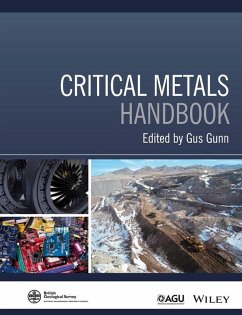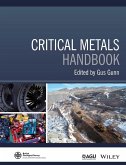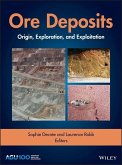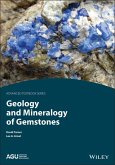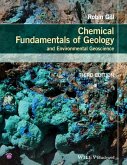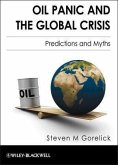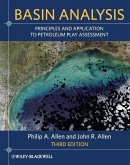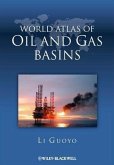Critical Metals Handbook (eBook, PDF)
Redaktion: Gunn, Gus


Alle Infos zum eBook verschenken

Critical Metals Handbook (eBook, PDF)
Redaktion: Gunn, Gus
- Format: PDF
- Merkliste
- Auf die Merkliste
- Bewerten Bewerten
- Teilen
- Produkt teilen
- Produkterinnerung
- Produkterinnerung

Hier können Sie sich einloggen

Bitte loggen Sie sich zunächst in Ihr Kundenkonto ein oder registrieren Sie sich bei bücher.de, um das eBook-Abo tolino select nutzen zu können.
Mankind is using a greater variety of metals in greater quantities than ever before. As a result there is increasing global concern over the long-term availability of secure and adequate supplies of the metals needed by society. Critical metals, which are those of growing economic importance that might be susceptible to future scarcity, are a particular worry. For many of these we have little information on how they are concentrated in the Earth's crust, how to extract them from their ores, and how to use, recycle and dispose of them effectively and safely. Published with the British…mehr
- Geräte: PC
- mit Kopierschutz
- eBook Hilfe
- Größe: 41.5MB
![Critical Metals Handbook (eBook, ePUB) Critical Metals Handbook (eBook, ePUB)]() Critical Metals Handbook (eBook, ePUB)119,99 €
Critical Metals Handbook (eBook, ePUB)119,99 €![Ore Deposits (eBook, PDF) Ore Deposits (eBook, PDF)]() Ore Deposits (eBook, PDF)174,99 €
Ore Deposits (eBook, PDF)174,99 €![Geology and Mineralogy of Gemstones (eBook, PDF) Geology and Mineralogy of Gemstones (eBook, PDF)]() David P. TurnerGeology and Mineralogy of Gemstones (eBook, PDF)76,99 €
David P. TurnerGeology and Mineralogy of Gemstones (eBook, PDF)76,99 €![Chemical Fundamentals of Geology and Environmental Geoscience (eBook, PDF) Chemical Fundamentals of Geology and Environmental Geoscience (eBook, PDF)]() Robin GillChemical Fundamentals of Geology and Environmental Geoscience (eBook, PDF)37,99 €
Robin GillChemical Fundamentals of Geology and Environmental Geoscience (eBook, PDF)37,99 €![Oil Panic and the Global Crisis (eBook, PDF) Oil Panic and the Global Crisis (eBook, PDF)]() Steven M. GorelickOil Panic and the Global Crisis (eBook, PDF)56,99 €
Steven M. GorelickOil Panic and the Global Crisis (eBook, PDF)56,99 €![Basin Analysis (eBook, PDF) Basin Analysis (eBook, PDF)]() Philip A. AllenBasin Analysis (eBook, PDF)55,99 €
Philip A. AllenBasin Analysis (eBook, PDF)55,99 €![World Atlas of Oil and Gas Basins (eBook, PDF) World Atlas of Oil and Gas Basins (eBook, PDF)]() Guoyu LiWorld Atlas of Oil and Gas Basins (eBook, PDF)107,99 €
Guoyu LiWorld Atlas of Oil and Gas Basins (eBook, PDF)107,99 €-
-
-
Dieser Download kann aus rechtlichen Gründen nur mit Rechnungsadresse in A, B, BG, CY, CZ, D, DK, EW, E, FIN, F, GR, HR, H, IRL, I, LT, L, LR, M, NL, PL, P, R, S, SLO, SK ausgeliefert werden.
- Produktdetails
- Verlag: John Wiley & Sons
- Seitenzahl: 456
- Erscheinungstermin: 20. Dezember 2013
- Englisch
- ISBN-13: 9781118755266
- Artikelnr.: 40180467
- Verlag: John Wiley & Sons
- Seitenzahl: 456
- Erscheinungstermin: 20. Dezember 2013
- Englisch
- ISBN-13: 9781118755266
- Artikelnr.: 40180467
- Herstellerkennzeichnung Die Herstellerinformationen sind derzeit nicht verfügbar.
Acknowledgements xiii
1 Metal resources use and criticality 1
T.E. Graedel Gus Gunn and Luis Tercero Espinoza
The geology and technology of metals 1
Key concepts 1
Definitions and terminology 3
Will we run out of minerals? 5
Geological assessment 6
Considerations of supply and demand 6
Recycling and reuse of metals 9
The concept of criticality 10
Assessments of criticality 11
Improving criticality assessment 14
Implications of criticality for corporate and governmental policy 16
Outlining this book 16
Acknowledgements 17
Note 18
References 18
2 The mining industry and the supply of critical minerals 20
David Humphreys
Suppliers of minerals - miners and explorers 21
Industry dynamics 23
Constraints on mineral supply response 27
Natural constraints 27
Economic constraints 29
Institutional constraints 31
Critical minerals and the role of China 34
Policy issues 38
Notes 39
References 39
3 Recycling of (critical) metals 41
Christian Hagelüken
Rationale and benefits 41
The urban mine 41
Recycling benefits 43
Status and challenges of recycling critical metals 45
The metals life cycle 45
Waste and resource legislation 47
The recycling value chain 47
Recycling challenges 48
The seven conditions for effective recycling 50
Recycling technologies 51
Collection and pre-processing 52
Metallurgical recovery 54
Status of recycling of the EU critical metals 57
The significance of life-cycle structures 58
Case study 1: Industrial PGM applications 59
Case study 2: Automotive PGM applications 60
Case study 3: Electronic PGM applications 60
Global flows of old products 60
Differences in recycling rates and pathways for improvement 61
Conclusion and the way forward 62
Innovation needs 62
Resource security as a societal driver for recycling 64
Mining and recycling as complementary systems 64
Conclusions 66
Notes 66
References 67
4 Antimony 70
Ulrich Schwarz-Schampera
Introduction 70
Definitions and characteristics 70
Abundance in the Earth 71
Mineralogy 71
Major deposit classes 72
Gold-antimony (epithermal) deposits 74
Greenstone-hosted quartz-carbonate vein and carbonate replacement deposits
77
Reduced magmatic gold systems 78
Extraction methods and processing 78
Mining 78
Ore processing beneficiation and conversion to metal 79
Specifications 82
Uses 82
Antimony trioxide 84
Sodium antimonate 84
Other non-metallurgical uses 85
Antimony metal 85
Recycling 85
Substitution 86
Resources and reserves 86
Production 87
Projects under development 90
World trade 91
Prices 92
Environmental aspects 94
Outlook 95
References 96
5 Beryllium 99
David L. Trueman and Phillip Sabey
Introduction 99
Properties of beryllium 99
Distribution and abundance in the Earth's crust 100
Uses of beryllium 100
Alloys containing less than 2% beryllium especially copper-beryllium 101
Pure beryllium metal and alloys containing over 60% beryllium 102
Beryllia (BeO) ceramics 103
World production 103
World trade 105
World resources 106
Mineralogy of beryllium 106
Beryllium deposits 107
Pegmatite deposits 107
Hydrothermal deposits 110
Mining and processing of beryllium 110
Beryl ores 110
Bertrandite ores 110
Processing of beryl and bertrandite to beryllium hydroxide 111
Production of metal and alloys from beryllium hydroxide 113
Production of beryllium oxide from beryllium hydroxide 113
Recycling 115
Substitution 116
Environmental aspects 116
Prices 118
Outlook 118
Note 119
References 119
6 Cobalt 122
Stephen Roberts and Gus Gunn
Introduction 122
Physical and chemical properties 122
Distribution and abundance in the Earth 122
Mineralogy 122
Deposit types 123
Hydrothermal deposits 123
Magmatic deposits 129
Laterites 130
Manganese nodules and cobalt-rich ferromanganese crusts on the seafloor 132
Extraction processing and refining 134
Cobalt from nickel sulfide ores 134
Contentsvii Cobalt from nickel laterite ores 134
Cobalt from copper-cobalt ores in DRC and Zambia 135
Other sources of cobalt 136
World production and trade 138
Resources and reserves 139
uses 140
Recycling 142
Substitution 142
Environmental issues 143
Prices 144
Outlook 144
Acknowledgements 146
Notes 146
References 146
7 Gallium 150
Thomas Butcher and Teresa Brown
Introduction 150
Physical and chemical properties 150
Mineralogy and distribution 150
Sources of gallium 151
Bauxite 151
Sphalerite (ZnS) 151
Other geological settings 152
Recovery methods and refining 152
Primary recovery 152
Secondary recovery 153
Refining and purification 155
Gallium in GaAs semiconductors 155
Specifications and uses 157
Gallium metal 157
Gallium antimonide 157
Gallium arsenide 157
Gallium chemicals 159
Gallium nitride 160
Gallium phosphide 162
Photovoltaics 162
Substitution 163
Environmental aspects 163
World resources and production 164
Production in 2010 164
Future supplies 166
World trade 167
Prices 167
Outlook 170
Acknowledgements 171
References 172
8 Germanium 177
Frank Melcher and Peter Buchholz
Introduction 177
Physical and chemical properties 177
Distribution and abundance in the Earth 177
Mineralogy 178
Deposit types 179
Accumulation of germanium in sulfide deposits 181
Enrichment of germanium in lignite and coal 185
Extraction methods processing and beneficiation 186
Extraction 186
Processing 186
Specifications 188
Germanium tetrachloride GeCl 4 188
Germanium dioxide GeO 2 188
First reduction metal 188
Production of zone-refined metal ('intrinsic' metal) 188
Single crystals 188
Uses 189
Recycling re-use and resource efficiency 189
Substitution 191
Environmental aspects of the life cycle of germanium and its products 192
Resources and reserves 192
Production 194
Future supplies 196
World trade 197
Prices 197
Outlook 198
Supply challenges 198
Demand drivers 199
Supply and demand scenario 200
Acknowledgments 200
Notes 200
References 200
9 Indium 204
Ulrich Schwarz-Schampera
Introduction 204
Physical and chemical properties 204
Abundance in the Earth's crust 205
Mineralogy 205
Major deposit classes 206
Base-metal sulfide deposits 209
Polymetallic vein-type deposits 209
Base-metal-rich tin-tungsten and skarn deposits 210
Base-metal-rich epithermal deposits 210
Extraction methods and processing 210
Mining 210
Processing beneficiation and conversion to metal 212
Indium production from copper ores 213
Indium production from tin ores 214
Indium recovery from secondary sources 214
Specifications and uses 214
Indium-tin oxide (ITO) 215
Alloys and solders 215
Semiconductors 216
Others 216
Resources and reserves 217
Production 218
Production from residues and scrap 220
Projects under development 221
Abandoned production 221
World trade 222
Prices 223
Recycling and substitution 224
Environmental aspects 225
Outlook 226
References 227
10 Lithium 230
Keith Evans
Introduction 230
Properties and abundance in the Earth 230
Mineralogy and deposit types 230
Pegmatites 232
Continental brines 232
Geothermal brines 234
Oilfield brines 234
Hectorite 234
Jadarite 235
Extraction methods and processing 236
Specification and uses 238
Recycling 240
Substitution 240
Environmental factors 241
World resources and production 241
Reserves and resources 241
Production 244
Current producers 245
Production costs 248
Future supplies 249
Pegmatite-based projects 249
Continental brines 250
Geothermal brine 251
Oilfield brine 251
Hectorite 252
Jadarite 253
World trade 253
Prices 254
Outlook 255
Acknowledgements 258
Notes 258
References 258
11 Magnesium 261
Neale R. Neelameggham and Bob Brown
Introduction 261
Physical and chemical properties 261
Distribution and abundance in the Earth 262
Mineralogy 262
Deposit types 263
Extraction methods processing and beneficiation 263
Nineteenth-century magnesium production processes 266
Commercial magnesium production processes of the twentieth century 266
Specifications and uses 267
Recycling re-use and resource efficiency 269
Substitution 271
Environmental aspects 272
Non-greenhouse-gas regulations - electrolytic magnesium production 272
Non-greenhouse-gas regulations - thermal magnesium 273
Greenhouse-gas emission studies 273
Contentsix World resources and production 275
Future supplies 277
World trade 277
Prices 277
Outlook 279
References 281
12 Platinum-group metals 284
Gus Gunn
Introduction 284
Properties and abundance in the Earth 284
Mineralogy 285
Major deposit classes 285
PGM-dominant deposits 286
Nickel-copper-dominant deposits 292
Other deposit types 293
Extraction and processing 294
Extraction methods 294
Processing 294
Specifications and uses 297
Uses of platinum palladium and rhodium 297
Uses of ruthenium iridium and osmium 300
Recycling re-use and resource efficiency 300
Substitution 301
Environmental issues 301
World resources and production 302
Resources and reserves 302
Production 302
World trade 304
Prices 306
Outlook 306
Acknowledgements 309
Note 309
References 310
13 Rare earth elements 312
Frances Wall
Introduction 312
Physical and chemical properties 312
Distribution and abundance in the Earth's crust 313
Mineralogy 315
Deposit types 317
Carbonatite-related REE deposits 319
Alkaline igneous rocks 323
Other hydrothermal veins 324
Iron oxide-apatite deposits including iron-oxide-copper-gold (IOCG)
deposits 324
Placer deposits (mineral sands) 324
Ion adsorption deposits 324
Seafloor deposits 325
By-products co-products and waste products 325
Extraction methods processing and beneficiation 325
Mining 325
Beneficiation 325
Extraction and separation of the REE 327
Specifications and uses 328
Recycling re-use and resource efficiency 328
Substitution 330
Environmental aspects 330
World resources and production 331
Future supplies 332
World trade 333
Prices 334
Outlook 336
Note 337
References 337
14 Rhenium 340
Tom A. Millensifer Dave Sinclair Ian Jonasson and Anthony Lipmann
Introduction 340
Physical and chemical properties 340
Distribution and abundance 341
Mineralogy 341
Deposit types 342
Porphyry deposits 342
Vein deposits 345
Sediment-hosted copper deposits 345
Uranium deposits 346
Magmatic nickel-copper-platinumgroup element (PGE) deposits 346
World resources and production 346
Future supplies 348
Extraction methods processing and beneficiation 350
Specifications and uses 352
Recycling and re-use 354
Catalysts 354
Superalloys 355
Substitution 355
Environmental issues 356
World trade 356
Prices 357
Outlook 358
References 359
15 Tantalum and niobium 361
Robert Linnen David L. Trueman and Richard Burt
Introduction 361
Physical and chemical properties 361
Distribution and abundance in the Earth 361
Mineralogy 362
Deposit types 363
Carbonatite deposits 363
Alkaline to peralkaline granites and syenites 367
Peraluminous pegmatites 368
Peraluminous granites 370
Extraction methods and processing 371
Specifications and uses 374
Recycling re-use and resource efficiency 375
Substitution 375
Environmental aspects of niobium and tantalum 376
Geopolitical aspects 376
World resources and production 377
Future supplies 379
Prices 380
Outlook 381
Note 382
References 382
16 Tungsten 385
Teresa Brown and Peter Pitfield
Introduction 385
Physical and chemical properties 385
Distribution and abundance in the Earth's crust 385
Mineralogy 386
Deposit types 386
Vein/stockwork deposits 387
Skarn deposits 389
Disseminated or greisen deposits 390
Porphyry deposits 390
Breccia deposits 391
Stratabound deposits 391
Pegmatite deposits 392
Pipe deposits 392
Hot-spring deposits 392
Placer deposits 392
Brine/evaporite deposits 392
Extraction methods processing and beneficiation 392
Extraction 392
Processing 393
Specifications and uses 395
Specifications 395
Uses 396
Recycling re-use and resource efficiency 398
Old scrap 398
New scrap 398
Unrecovered scrap 399
Recycling methods 399
Substitution 399
Environmental aspects of the life cycle of the metal and its products 399
World resources and production 400
Resources and reserves 400
Production 401
Future supplies 402
World trade 404
Prices 406
Outlook 406
Acknowledgements 409
References 409
Appendices 414
Glossary of technical terms 419
Index 431
Acknowledgements xiii
1 Metal resources use and criticality 1
T.E. Graedel Gus Gunn and Luis Tercero Espinoza
The geology and technology of metals 1
Key concepts 1
Definitions and terminology 3
Will we run out of minerals? 5
Geological assessment 6
Considerations of supply and demand 6
Recycling and reuse of metals 9
The concept of criticality 10
Assessments of criticality 11
Improving criticality assessment 14
Implications of criticality for corporate and governmental policy 16
Outlining this book 16
Acknowledgements 17
Note 18
References 18
2 The mining industry and the supply of critical minerals 20
David Humphreys
Suppliers of minerals - miners and explorers 21
Industry dynamics 23
Constraints on mineral supply response 27
Natural constraints 27
Economic constraints 29
Institutional constraints 31
Critical minerals and the role of China 34
Policy issues 38
Notes 39
References 39
3 Recycling of (critical) metals 41
Christian Hagelüken
Rationale and benefits 41
The urban mine 41
Recycling benefits 43
Status and challenges of recycling critical metals 45
The metals life cycle 45
Waste and resource legislation 47
The recycling value chain 47
Recycling challenges 48
The seven conditions for effective recycling 50
Recycling technologies 51
Collection and pre-processing 52
Metallurgical recovery 54
Status of recycling of the EU critical metals 57
The significance of life-cycle structures 58
Case study 1: Industrial PGM applications 59
Case study 2: Automotive PGM applications 60
Case study 3: Electronic PGM applications 60
Global flows of old products 60
Differences in recycling rates and pathways for improvement 61
Conclusion and the way forward 62
Innovation needs 62
Resource security as a societal driver for recycling 64
Mining and recycling as complementary systems 64
Conclusions 66
Notes 66
References 67
4 Antimony 70
Ulrich Schwarz-Schampera
Introduction 70
Definitions and characteristics 70
Abundance in the Earth 71
Mineralogy 71
Major deposit classes 72
Gold-antimony (epithermal) deposits 74
Greenstone-hosted quartz-carbonate vein and carbonate replacement deposits
77
Reduced magmatic gold systems 78
Extraction methods and processing 78
Mining 78
Ore processing beneficiation and conversion to metal 79
Specifications 82
Uses 82
Antimony trioxide 84
Sodium antimonate 84
Other non-metallurgical uses 85
Antimony metal 85
Recycling 85
Substitution 86
Resources and reserves 86
Production 87
Projects under development 90
World trade 91
Prices 92
Environmental aspects 94
Outlook 95
References 96
5 Beryllium 99
David L. Trueman and Phillip Sabey
Introduction 99
Properties of beryllium 99
Distribution and abundance in the Earth's crust 100
Uses of beryllium 100
Alloys containing less than 2% beryllium especially copper-beryllium 101
Pure beryllium metal and alloys containing over 60% beryllium 102
Beryllia (BeO) ceramics 103
World production 103
World trade 105
World resources 106
Mineralogy of beryllium 106
Beryllium deposits 107
Pegmatite deposits 107
Hydrothermal deposits 110
Mining and processing of beryllium 110
Beryl ores 110
Bertrandite ores 110
Processing of beryl and bertrandite to beryllium hydroxide 111
Production of metal and alloys from beryllium hydroxide 113
Production of beryllium oxide from beryllium hydroxide 113
Recycling 115
Substitution 116
Environmental aspects 116
Prices 118
Outlook 118
Note 119
References 119
6 Cobalt 122
Stephen Roberts and Gus Gunn
Introduction 122
Physical and chemical properties 122
Distribution and abundance in the Earth 122
Mineralogy 122
Deposit types 123
Hydrothermal deposits 123
Magmatic deposits 129
Laterites 130
Manganese nodules and cobalt-rich ferromanganese crusts on the seafloor 132
Extraction processing and refining 134
Cobalt from nickel sulfide ores 134
Contentsvii Cobalt from nickel laterite ores 134
Cobalt from copper-cobalt ores in DRC and Zambia 135
Other sources of cobalt 136
World production and trade 138
Resources and reserves 139
uses 140
Recycling 142
Substitution 142
Environmental issues 143
Prices 144
Outlook 144
Acknowledgements 146
Notes 146
References 146
7 Gallium 150
Thomas Butcher and Teresa Brown
Introduction 150
Physical and chemical properties 150
Mineralogy and distribution 150
Sources of gallium 151
Bauxite 151
Sphalerite (ZnS) 151
Other geological settings 152
Recovery methods and refining 152
Primary recovery 152
Secondary recovery 153
Refining and purification 155
Gallium in GaAs semiconductors 155
Specifications and uses 157
Gallium metal 157
Gallium antimonide 157
Gallium arsenide 157
Gallium chemicals 159
Gallium nitride 160
Gallium phosphide 162
Photovoltaics 162
Substitution 163
Environmental aspects 163
World resources and production 164
Production in 2010 164
Future supplies 166
World trade 167
Prices 167
Outlook 170
Acknowledgements 171
References 172
8 Germanium 177
Frank Melcher and Peter Buchholz
Introduction 177
Physical and chemical properties 177
Distribution and abundance in the Earth 177
Mineralogy 178
Deposit types 179
Accumulation of germanium in sulfide deposits 181
Enrichment of germanium in lignite and coal 185
Extraction methods processing and beneficiation 186
Extraction 186
Processing 186
Specifications 188
Germanium tetrachloride GeCl 4 188
Germanium dioxide GeO 2 188
First reduction metal 188
Production of zone-refined metal ('intrinsic' metal) 188
Single crystals 188
Uses 189
Recycling re-use and resource efficiency 189
Substitution 191
Environmental aspects of the life cycle of germanium and its products 192
Resources and reserves 192
Production 194
Future supplies 196
World trade 197
Prices 197
Outlook 198
Supply challenges 198
Demand drivers 199
Supply and demand scenario 200
Acknowledgments 200
Notes 200
References 200
9 Indium 204
Ulrich Schwarz-Schampera
Introduction 204
Physical and chemical properties 204
Abundance in the Earth's crust 205
Mineralogy 205
Major deposit classes 206
Base-metal sulfide deposits 209
Polymetallic vein-type deposits 209
Base-metal-rich tin-tungsten and skarn deposits 210
Base-metal-rich epithermal deposits 210
Extraction methods and processing 210
Mining 210
Processing beneficiation and conversion to metal 212
Indium production from copper ores 213
Indium production from tin ores 214
Indium recovery from secondary sources 214
Specifications and uses 214
Indium-tin oxide (ITO) 215
Alloys and solders 215
Semiconductors 216
Others 216
Resources and reserves 217
Production 218
Production from residues and scrap 220
Projects under development 221
Abandoned production 221
World trade 222
Prices 223
Recycling and substitution 224
Environmental aspects 225
Outlook 226
References 227
10 Lithium 230
Keith Evans
Introduction 230
Properties and abundance in the Earth 230
Mineralogy and deposit types 230
Pegmatites 232
Continental brines 232
Geothermal brines 234
Oilfield brines 234
Hectorite 234
Jadarite 235
Extraction methods and processing 236
Specification and uses 238
Recycling 240
Substitution 240
Environmental factors 241
World resources and production 241
Reserves and resources 241
Production 244
Current producers 245
Production costs 248
Future supplies 249
Pegmatite-based projects 249
Continental brines 250
Geothermal brine 251
Oilfield brine 251
Hectorite 252
Jadarite 253
World trade 253
Prices 254
Outlook 255
Acknowledgements 258
Notes 258
References 258
11 Magnesium 261
Neale R. Neelameggham and Bob Brown
Introduction 261
Physical and chemical properties 261
Distribution and abundance in the Earth 262
Mineralogy 262
Deposit types 263
Extraction methods processing and beneficiation 263
Nineteenth-century magnesium production processes 266
Commercial magnesium production processes of the twentieth century 266
Specifications and uses 267
Recycling re-use and resource efficiency 269
Substitution 271
Environmental aspects 272
Non-greenhouse-gas regulations - electrolytic magnesium production 272
Non-greenhouse-gas regulations - thermal magnesium 273
Greenhouse-gas emission studies 273
Contentsix World resources and production 275
Future supplies 277
World trade 277
Prices 277
Outlook 279
References 281
12 Platinum-group metals 284
Gus Gunn
Introduction 284
Properties and abundance in the Earth 284
Mineralogy 285
Major deposit classes 285
PGM-dominant deposits 286
Nickel-copper-dominant deposits 292
Other deposit types 293
Extraction and processing 294
Extraction methods 294
Processing 294
Specifications and uses 297
Uses of platinum palladium and rhodium 297
Uses of ruthenium iridium and osmium 300
Recycling re-use and resource efficiency 300
Substitution 301
Environmental issues 301
World resources and production 302
Resources and reserves 302
Production 302
World trade 304
Prices 306
Outlook 306
Acknowledgements 309
Note 309
References 310
13 Rare earth elements 312
Frances Wall
Introduction 312
Physical and chemical properties 312
Distribution and abundance in the Earth's crust 313
Mineralogy 315
Deposit types 317
Carbonatite-related REE deposits 319
Alkaline igneous rocks 323
Other hydrothermal veins 324
Iron oxide-apatite deposits including iron-oxide-copper-gold (IOCG)
deposits 324
Placer deposits (mineral sands) 324
Ion adsorption deposits 324
Seafloor deposits 325
By-products co-products and waste products 325
Extraction methods processing and beneficiation 325
Mining 325
Beneficiation 325
Extraction and separation of the REE 327
Specifications and uses 328
Recycling re-use and resource efficiency 328
Substitution 330
Environmental aspects 330
World resources and production 331
Future supplies 332
World trade 333
Prices 334
Outlook 336
Note 337
References 337
14 Rhenium 340
Tom A. Millensifer Dave Sinclair Ian Jonasson and Anthony Lipmann
Introduction 340
Physical and chemical properties 340
Distribution and abundance 341
Mineralogy 341
Deposit types 342
Porphyry deposits 342
Vein deposits 345
Sediment-hosted copper deposits 345
Uranium deposits 346
Magmatic nickel-copper-platinumgroup element (PGE) deposits 346
World resources and production 346
Future supplies 348
Extraction methods processing and beneficiation 350
Specifications and uses 352
Recycling and re-use 354
Catalysts 354
Superalloys 355
Substitution 355
Environmental issues 356
World trade 356
Prices 357
Outlook 358
References 359
15 Tantalum and niobium 361
Robert Linnen David L. Trueman and Richard Burt
Introduction 361
Physical and chemical properties 361
Distribution and abundance in the Earth 361
Mineralogy 362
Deposit types 363
Carbonatite deposits 363
Alkaline to peralkaline granites and syenites 367
Peraluminous pegmatites 368
Peraluminous granites 370
Extraction methods and processing 371
Specifications and uses 374
Recycling re-use and resource efficiency 375
Substitution 375
Environmental aspects of niobium and tantalum 376
Geopolitical aspects 376
World resources and production 377
Future supplies 379
Prices 380
Outlook 381
Note 382
References 382
16 Tungsten 385
Teresa Brown and Peter Pitfield
Introduction 385
Physical and chemical properties 385
Distribution and abundance in the Earth's crust 385
Mineralogy 386
Deposit types 386
Vein/stockwork deposits 387
Skarn deposits 389
Disseminated or greisen deposits 390
Porphyry deposits 390
Breccia deposits 391
Stratabound deposits 391
Pegmatite deposits 392
Pipe deposits 392
Hot-spring deposits 392
Placer deposits 392
Brine/evaporite deposits 392
Extraction methods processing and beneficiation 392
Extraction 392
Processing 393
Specifications and uses 395
Specifications 395
Uses 396
Recycling re-use and resource efficiency 398
Old scrap 398
New scrap 398
Unrecovered scrap 399
Recycling methods 399
Substitution 399
Environmental aspects of the life cycle of the metal and its products 399
World resources and production 400
Resources and reserves 400
Production 401
Future supplies 402
World trade 404
Prices 406
Outlook 406
Acknowledgements 409
References 409
Appendices 414
Glossary of technical terms 419
Index 431
